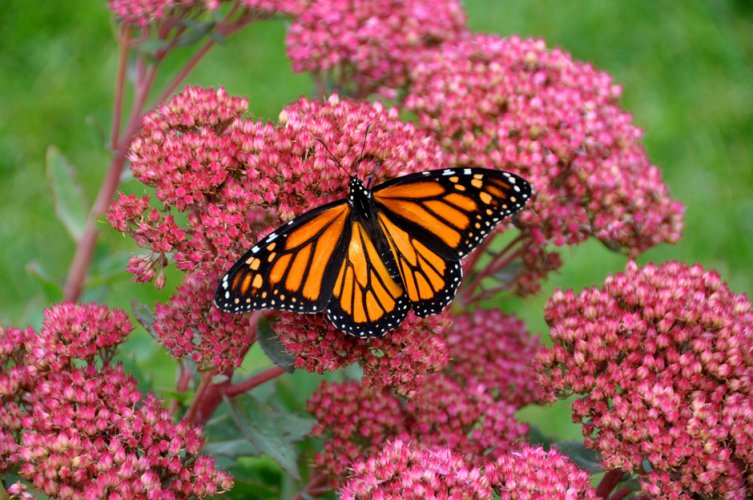
The Hitchhiker's Guide to Migration
Let's begin with a confession: Until I began reviewing IMAX documentaries recently, I'd never really considered them films. They’d always seemed like giant-screen amusements—not gimmicks, per se, but reality-based thrill rides meant to make audiences dizzy, awestruck by sheer scale, or both. I get wobbly thinking about the high-wire scene from a circus movie I saw at Six Flags twenty-plus years ago, and recall fondly the otherworldly wonder James Cameron instilled in me with 2005’s Aliens of the Deep. Still, I’ve long thought of IMAX movies as part of a singular brand entity, and not as diverse movies in their own right that happen to share a novel format.
Flight of the Butterflies really turned things around for me. Unlike Journey to Space or Rocky Mountain Express (two films I enjoyed immensely, for different reasons) director/co-writer Mike Slee's film is a mini-docudrama about Dr. Fred Urquhart (Gordon Pinsent), a Toronto scientist who spent nearly five decades uncovering the secrets of Monarch butterfly migration. He and his wife, Norah (Patricia Phillips) formed the Insect Migration Association and recruited volunteers from all over North America to help tag and track Monarchs, and to make note of how various environmental conditions affect their lifecycle.
Running parallel to the Urquharts' story is that of "Dana" (short for Danaus Plexippus), a Monarch whom we meet in Texas. Over the course of her brief life, she will spawn two more generations, who will then complete the instinctual journey north into Canada and then back down south. For years, the Urquharts were baffled by what seemed to be a big disappearing act on the part of the Monarchs. None of their thousands of far-flung associates could determine where these millions of creatures went during the harshest winter months.
Slee and co-writer Wendy Mackeigan tie the two stories together wonderfully, with the Urquhart's ups and downs serving as decades-spanning flashbacks to Dana's present-day journey. Both narratives are equally gripping: Fred and Norah hit a multi-year roadblock in their studies, and Dana's progeny struggle to evade crop dusters and predators, and to navigate various kinds of terrain (using evolutionary enhancements that scientists still marvel at today). The scene that best encapsulates man and Monarch's tumultuous relationship involves Dana narrowly escaping a thresher as it clears a field teeming with butterfly nurseries. It's right out of the opening of The Hitchhiker's Guide to the Galaxy, in which aliens casually wipe Earth off the galactic map to make room for a space highway.
It's here that I began to draw comparisons to Journey to Space. To the Monarch, there is no more to life than being born, developing into a creature capable of reproducing, and dying after the species has (hopefully) been given another boost. Butterflies have no concept of Texas or Toronto as places made of people, with cultures who interact with other cultures on the other side of a vast planet they'll never fully experience. Yet, there are members of this alien species (humans) who are hell-bent on understanding Monarchs, on tracking them and helping preserve their ability to exist--even though other members of the same species don't care about these pretty but inconvenient "bugs". In mankind's quest to learn more about the far reaches of space, is Mars our Toronto? If so, what would our Japan be? Will we ever find out?
The Monarchs' disappearance presents an existential challenge to the Urquharts' research. Flight of the Butterflies presents us with a quiet and truly heartbreaking scene of Fred, sitting down next to Norah in the middle of their small desert camp and realizing that he may have spent two-thirds of his life chasing an unsolvable mystery. This moment happened in the mid-seventies, so it's easy to look back on all the technological advances in the decades since and think, "We'd never have this problem today." But at the cusp of his greatest discovery, Fred found himself completely at a loss, without the benefit of sophisticated global networks or pocket databases with instant clues as to what his next steps should be.
I won't tell you how the Urquharts overcame this adversity, but the film's climactic scene is one of profound beauty. Like most of Flight of the Butterflies' nature scenes, Slee and DP Simon De Glanville deliver inconceivably rich and intimate detail of the Monarch's every developmental stage. Referring back to James Cameron again, watching Dana lay an egg on a leaf reminded me of the first time I'd seen the Xenomorph Queen in Aliens--only this was real and impossible to appreciate with the naked eye.
My one gripe with the film is the infrequent integration of CGI with the documentary footage. There's a scene towards the middle in which a highly detailed and mostly convincing Monarch flies over the country, flying at the camera so as to make every scale and hair a wondrously tactile temptation. It would not have been possible to capture this precise movement with traditional photography, so Slee and company rendered it with computers. The results are spectacular, but the model instantly caused me to question what else I'd seen (or was about to see) that might be the product of digital trickery. The answer doesn't truly matter, since the filmmakers serve their story and overall message admirably, but I lost an ounce of magic watching that big damned bug.
Like Dana and the Urquharts, I feel like I've reached a new stage in my development. Learning to appreciate IMAX movies as art and not monolithic escapism isn't a groundbreaking scientific discovery, but it represents an evolution in the way I think about film. These first steps are exciting, and I can't wait to find my Toronto.

